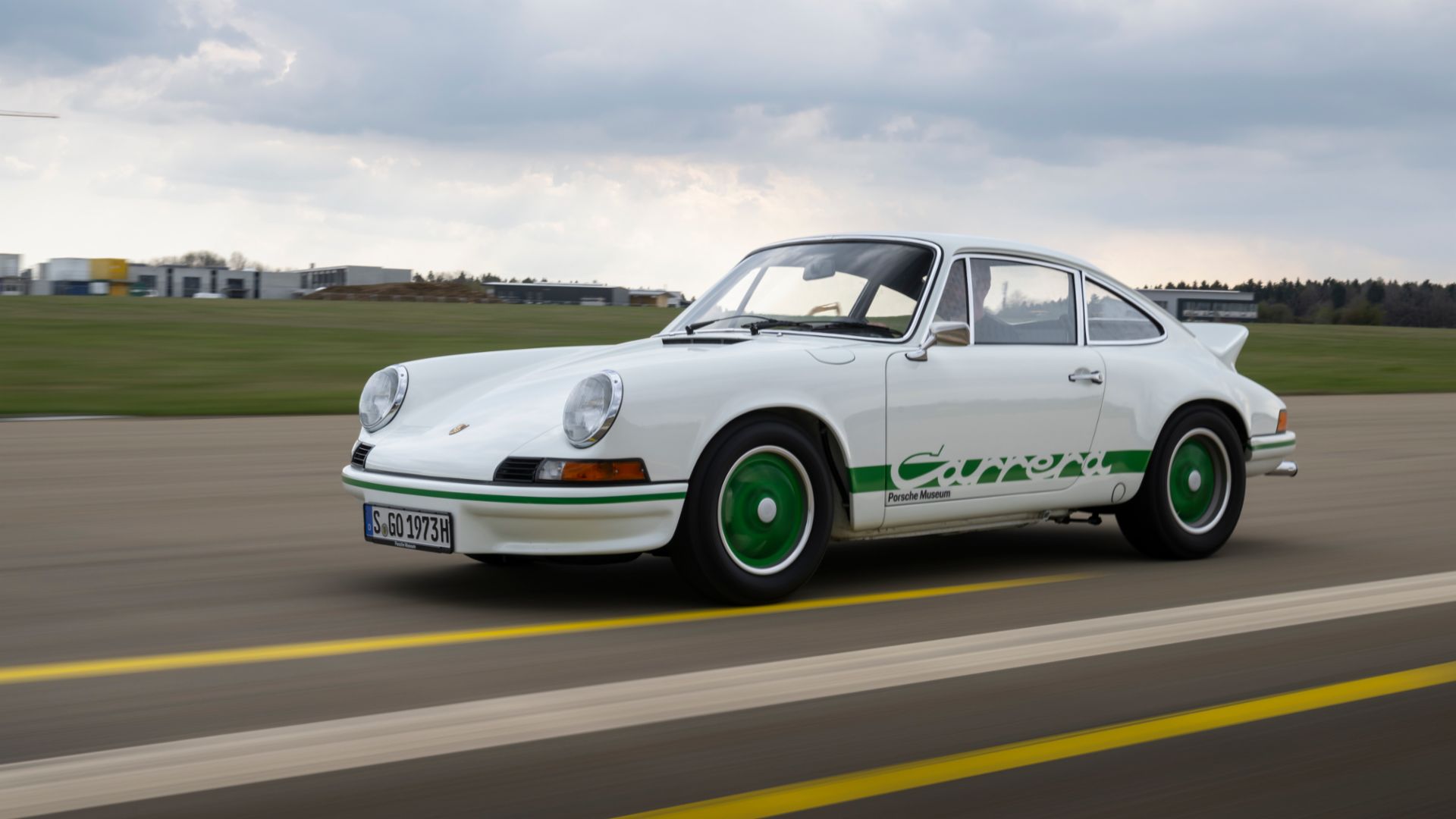The Porsche 911 Carrera RS 2.7 set the template for modern 911 track cars, so to celebrate its 50th anniversary this year, Porsche gathered World Rally champion Walter Röhrl, 24 Hours of Le Mans winner Timo Bernhard, and a selection of classic 911s to recount the history of the Carrera RS 2.7 and its successors.
Unveiled in 1972 as a homologation special, the Carrera RS 2.7 is instantly recognizable thanks to its ducktail rear spoiler. It was the first production sports car with spoilers, including the ducktail and a smaller front lip spoiler. The ducktail cancelled out aerodynamic lift, reduced drag, and even improved engine cooling. It also became an iconic styling feature that’s now making a comeback on the 2023 Porsche 911 Sport Classic.
That familiar shape started out as a simple panel held in place by a piece of wood. Protruding out from the 911’s sloping rear, wind tunnel testing showed it cancelled out lift and produced downforce.
This was also the first time Porsche used the Carrera name for a 911 (it had previously been used for a 356 variant in 1955). Porsche brought the name, which means “race” in Spanish, back to signify the RS 2.7 was something special. That’s a bit ironic considering the Carrera name is now used for base 911 models.
Thinner sheetmetal and glass, and a lack of insulation, also made the Carrera RS 2.7 lighter than other 911 models of the time. It was faster as well, capable of 0-60 mph in 5.5 seconds and a top speed of 149 mph.
Propelling it to that speed was a 2.7-liter flat-6. It generated 210 hp which was sent to the rear wheels through a 5-speed manual transmission. The RS 2.7 was also the first production 911 with rear tires wider than its front tires, which helped improve traction.

Porsche 911 Carrera RS 2.7
Porsche hoped to enter the RS 2.7 in the FIA Group 4 category, which required building 500 units for homologation. They sold out in just three months, so Porsche ended building 1,580 copies (including 200 lightweight versions) in a production run that stretched into 1973. The Carrera RS 2.7 had a successful career in sports car racing and rallying as well, but was soon replaced by the 2.8 RS and RSR 3.0 racers, which also make brief appearances in the video.
The RS 2.7 was followed by other hardcore 911 road cars, including the 911 GT3 RS 4.0, which are also featured in the video. Launched in 2011 as a send-off for the 997-generation 911 GT3, it featured a 4.0-liter flat-6 producing 493 hp. While the RS 4.0 does have a small ducktail, it’s surrounded by a much larger rear wing—showing how spoilers have evolved over the decades.
The 2023 Porsche 911 GT3 RS continues the RS tradition of low weight and advanced aerodynamics. But its elaborate system of ducts and vents, along with an adjustable wing featuring a Formula 1-style drag reduction system (DRS), makes even the GT3 RS 4.0 look old fashioned. Yet Porsche considers the GT3 RS to be the Carrera RS’s descendent, even showing a one-off version in the original car’s green-and-white livery.

buy ivermectin 12 mg – stromectol oral tegretol 400mg for sale
purchase isotretinoin pill – decadron 0,5 mg over the counter buy zyvox 600mg online
buy amoxil pills for sale – amoxicillin over the counter ipratropium 100 mcg canada
buy zithromax pills – buy nebivolol sale purchase nebivolol online
gabapentin 800mg drug – buy generic gabapentin 600mg buy itraconazole no prescription
augmentin 625mg ca – ketoconazole 200mg us cymbalta us
augmentin 1000mg without prescription – order nizoral 200 mg without prescription cymbalta 40mg uk
oral tadalafil 20mg – cheap viagra tablets buy viagra generic
sildenafil 100mg without prescription – order tadalafil 5mg sale cialis 40mg us
cenforce 100mg tablet – buy metformin 500mg sale order generic glucophage
buy cheap prilosec – buy tenormin 50mg pill buy generic tenormin
cytotec cost – misoprostol medication cost diltiazem 180mg
zovirax for sale online – buy zovirax online buy rosuvastatin 10mg sale
buy domperidone 10mg without prescription – oral motilium order cyclobenzaprine 15mg online
order motilium – buy flexeril sale flexeril online order
order inderal 20mg sale – methotrexate us methotrexate 10mg usa
buy warfarin cheap – warfarin 5mg pill buy cozaar no prescription
buy levofloxacin 250mg pill – cheap avodart generic ranitidine 150mg
buy nexium without a prescription – topiramate 200mg ca order sumatriptan pill
buy generic mobic for sale – order celebrex 100mg generic buy tamsulosin 0.4mg online